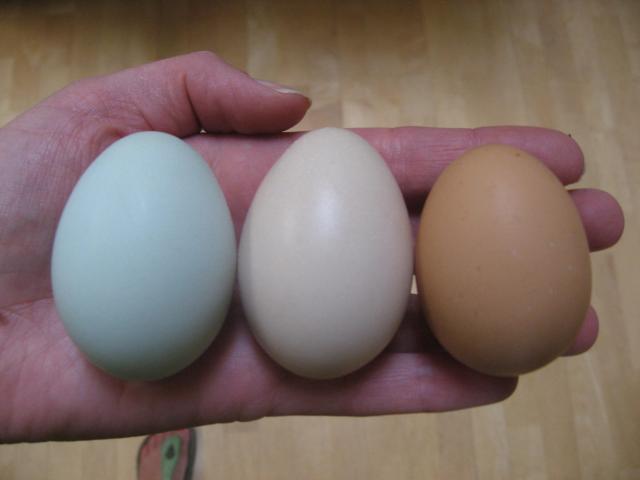"Genetics of eggshell color:
Brown eggshell color is a complex trait and as many as 13 genes have been proposed to account for the range in eggshell color. The white eggshell color is due to an absence of blue and brown, and perhaps some modifying factors (genes), since there are different shades of white. The blue eggshell gene, O, expresses if it is present which is why it is considered to be dominant. The gene symbol for the recessive, wild-type gene is o or o+. My understanding at present is that the locations of the brown eggshell genes are not known and it is not known how many brown modifying genes there are or where they are in relationship to the genes of known locations. Brown may itself be just an array of white modifiers. There is a recessive sex-linked gene, pr, that inhibits the expression of brown eggshell genes and can be used to help remove the brown tint from white eggs, for example.
The brown pigment, ooporphyrin, is deposited primarily on the outside of the eggshell and is a chemical compound resulting from hemoglobin metabolism. In fact, much of the brown pigment can be buffed off with a common kitchen (plastic) scrubbing sponge and warm soapy water. The blue eggshell pigment, oocyanin, is a byproduct of bile formation and is present throughout the eggshell.
The eggshell color genes interact in the following way. The effect of the blue gene is dominant over white. The effect of the brown gene is dominant over white. When blue and brown genes are both present, both genes contribute to the eggshell color making the eggs appear green. In this case, the inside surface of the eggshell will be significantly less green and more blue than the outside surface, which is where most of the brown pigment is.
Since the blue and brown eggshell color genes should be at different locations, we need at least two pairs of genes to describe the genotypes of the blue, white, green and brown layers. For the purposes of this discussion, I use the fictitious symbol, Br, to indicate a brown eggshell color gene. I represent the complementary recessive gene that takes the place of Br when it is absent as "br" (lack of brown gene). We can represent the genotype of a blue eggshell layer as (O, O) with (br, br). Blue and white genes, (O, o) with (br, br) also yields a blue egg, but perhaps a lighter blue. The pair of eggshell color genes, (O, O) with (Br, Br), are the genes for producing a green egg, (o, o) with (Br, Br) produces a brown egg and (o, o) with (br, br) yields a white egg. Females having one blue gene and one or more brown genes will lay eggs having a greenish color. My personal experience with eggshell color makes me believe that this genetics picture of eggshell color is oversimplified (there are certainly more than one gene for brown eggshell color. In order to account for the wide range of shades of brown eggs we see in our Sil-Go-Link line, there must be a relatively large number of eggshell color modifying genes that are not yet known. Most people accept a rule of thumb to the effect that a daughter will lay eggs that are a color between that of the parent lines.
To explore the genetics of eggshell color, lets cross a green egg layer (faux-Araucana or Easter Egg Chicken) with a white egg layer (Leghorn). Here as before, I will use the fictitous symbol "Br" to represent brown eggshell genes. The genes of the green egg layer are (O, O) with (Br, Br) assuming the locations of the blue and brown genes are not the same. The Leghorn is (o, o) with (br, br) for eggshell color (white). In this example, the daughters will all have one gene for blue eggshell color and one gene for brown. They will all be green egg layers! My personal experience with eggshell color genetics leads me to believe it is more complex than this. There certainly must be a number of brown eggshell genes and once you have them, it is difficult to breed them out completely."
This is on
http://sellers.kippenjungle.nl/page2.html#t8


